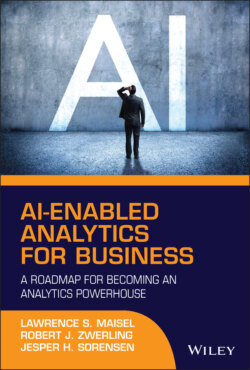Читать книгу AI-Enabled Analytics for Business - Lawrence S. Maisel - Страница 32
NOTE TO EXECUTIVES
ОглавлениеThe adage that software projects need executive support is very true in analytics, as analytics will change decisions, and change requires executive leadership. Executives, even when they want to develop a data-driven culture, often diminish or destroy its implementation.
The primary failure of analytics projects comes from executives who do not accept the use of analytics, perceive its benefits, have clarity of vision and understanding of AI/analytics, or have the leadership to discipline their companies to build an Analytics Culture.
Here is a true tale of a CEO (we will call him Jimmy) who runs a CPG manufacturing company (we will call it JimCo) of about $500 million that sells its products to distributors that then resell the products to retailers. In this business model, the shipments of products from JimCo to its distributors are known as shipments, and the shipments from the distributor to the distributor's retailers are called depletions. In this case, JimCo has data on both shipments and depletions.
Jimmy was forward-thinking to use ML to forecast depletions. The AI model worked well and had a last recorded accuracy for the full year 2020 of 93% across a representative swath of the company's business.
The company installed new master planning software for manufacturing that required increased accurate forecasts of shipments. While the ML forecast worked well for depletions, the characteristics of shipment data were significantly different, and the ML algorithm yielded materially lower accuracy of 86% across the same swath of business.
In search of better shipment forecast accuracy, the manager in charge of the depletion forecast (we will call him Bert) found a software company with a new approach to AI forecasting and ran a proof-of-concept (POC) test. Figure 3.1 displays the percent error of the forecast made 12 months in advance by the new POC software compared to the existing ML model across five major SKUs. As presented, the POC software achieved materially higher forecast accuracy for shipments across three of the SKUs and overall had a total error of only about 5% one year in advance (95% accuracy) vs. the ML model with a 14% error (86% accuracy).5
Figure 3.1 Forecast error comparison.
Further, the POC was extended to depletions, where the POC software achieved forecast accuracy to 99% vs. the ML model's 93%. This POC software also had other extensive AI-enabled analytics applications that could add significant benefits in sales, finance, and inventory.
The new analytics software was brought to Jimmy's attention. However, Jimmy's response was, essentially, to counsel Bert to “stay in his lane,” as requests for business improvements should be initiated from the business units.
It is understandable that Jimmy is hesitant to drive change, since change is the hardest item to tackle; but ignoring material benefits to business performance lacks prudence and is counter to the CEO role of continuously improving his business's performance.
So, in wonderful simplicity, it is down to the CEO (or business unit executive) to make analytics a part and priority of the business. A paper from McKinsey & Company, “A CEO guide for avoiding the ten traps that derail digital transformations,” by Arun Arora et al., makes this point and tags the top three CEO mistakes: Excess Caution, Fear of Unknown, and Lack of Focus.6
In Chapter 6, we will discuss the three essential responsibilities for executives to achieve an Analytics Culture: focus, budget, and bandwidth. Focus is keeping the organization on the tactical Roadmap, which executives typically derail with special projects. Budget is simply allocating sufficient funds to buy AI-enabled software and train people; but too often, executives attempt to “cheap” a solution by restricting software or training. Bandwidth is enabling staff with the time to learn the tools and apply the techniques of analytics; yet executives will not relieve staff of any responsibility, and instead, staff must work harder to incorporate a new scope without any supporting resources.
Executives must make the jump from just seeing data and reporting information to decisions from unbiased predictions of the future. Those who react to the future when the future arrives face certain peril from those who use AI-enabled analytics to plan to make the future happen.
